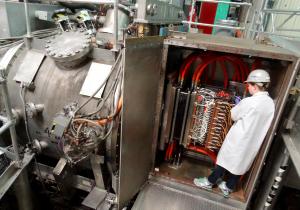DIII-D tokamak: creating and controlling hot plasmas just got easier
24 Oct 2016
Researchers working at the DIII-D National Fusion Facility at General Atomics (US) have succeeded in developing new flexibility for the neutral particle beam system, enabling a dramatic increase in the ability to both create and control hotter plasmas. The work, in collaboration with scientists from the University of California-Irvine and the Princeton Plasma Physics Laboratory, will be published in the January 2017 edition of Nuclear Fusion.
Ashley Harris from the Neutral Beam Team at General Atomics works on the system that injects 20 MW of power into the DIII-D tokamak ... or the equivalent of the power used in approximately 15,000 homes. Photo: GA
The increase in beam flexibility improves plasma control by allowing precise variation of the beam parameters during the approximately six-second plasma shots and, in the process, demonstrating unprecedented control of plasma behaviour. The neutral beam system injects up to 20 megawatts of power—equivalent to the power use of ~15,000 homes. Changing the way this system operates is a significant effort considering the size and complexity of each beam system (there are four truck-sized housings and eight beams at DIII-D).
Until this breakthrough, neutral beams have operated by accelerating ions through high voltage (~90,000 V) that is fixed in time, and then passing them through a chamber of dense gas where they neutralize and fly into the tokamak plasma.
High acceleration voltage is necessary to maximize the velocity of the resulting neutral atom and beam heating power. Experiments in recent years have shown that the velocity of the beam particles can produce or amplify electromagnetic plasma waves that then kick those particles out of the plasma and cause them to smash into the walls of the tokamak. This presents a dilemma: high beam power is necessary to produce high plasma temperatures, but the beam particle loss reduces the plasma temperature and can lead to costly damage along the tokamak walls.
The solution: varying the beam voltage in real-time allows for both a reduction of beam particle losses due to plasma waves and the maximization of input beam power. As the plasma is heated, the behaviour of the plasma waves changes such that beam particles of different velocities interact with the waves. The DIII-D neutral beams can be given preprogrammed voltage profiles that minimize wave-particle interactions. This limits interference, allowing the beam particle voltage to later increase to maximum levels, thereby increasing the potential for producing fusion energy.
Future work will extend the voltage range and speed of the neutral beam system. DIII-D experiments will then be capable of applying this new technique to an even wider range of plasmas, taking advantage of the control and diagnostic opportunities it provides. Ultimately, these experiments are intended to unravel some of the physics mysteries behind wave-particle interactions and other plasma behaviours in fusion-relevant regimes.
Read the General Atomics press release here.


